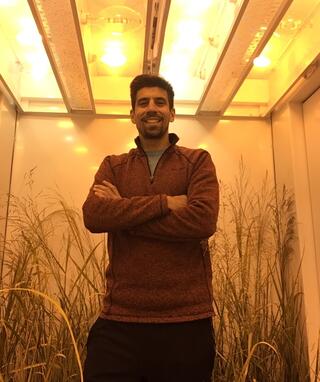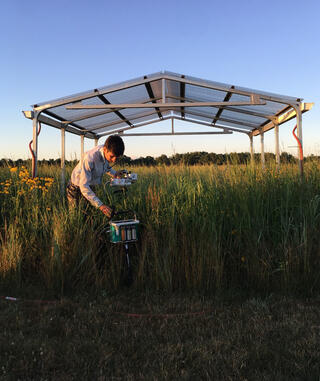
As the Keegstra Bioenergy Research Fellow exploring carbon flux in switchgrass, Mauricio Tejera is working with Berkley Walker and Lisa Tiemann at Michigan State University to investigate how carbon partitioning shifts within and among plant tissues, microbes, and the environment in response to abiotic stresses. Mauricio started his position in April. Connect with him at mauri@msu.edu.
Tell us a little about your background. What and where did you study before joining GLBRC?
I'm from Uruguay. Uruguay is a very small country, just bigger than the Lower Peninsula, and there's only one state school run by the government. I did my undergrad there in the School of Sciences at Universidad de la Republica, where I got a very wide basis in everything from math to geology and paleontology, but not as much plant biology as I would have liked. So then for my master's, I went to agronomy, which solidified my love for plant biology. I was studying how different perennial plants—grasses and legumes—interact with each other in pastures in Uruguay, and what was the most optimum species combination that would offer forage year-round.

My master's advisor did his Ph.D. at Iowa State. I had this window in 2013 when my plants were growing and I didn't have to measure them, so I went to Iowa State for an internship. I worked with sorghum in a breeding program, and while I was working I met with different professors. I met Emily Heaton, and it was a perfect fit. After I finished my master's I moved to Iowa for my Ph.D. That was when I made the switch to bioenergy crops and I studied Miscanthus giganteus, aging in perennial grasses, and nitrogen fertilization effects.
Why are you interested in bioenergy research? Why do you think it is important?
In the School of Sciences, it was all about the love of science—like, you just want to study plants because they are amazing for the world. When I went to agronomy, it was more about how you need to make profit off these. It took me a bit to make that mental transition, but I think that's one of the things that really drives me towards bioenergy crops. Those two worlds, my love for plants and making something that is meaningful for people, they intersect right there in bioenergy crops.
Why plants?
If I were to be a bit poetic about this, I would say my academic career is a love story. I just love plants, have since a very young age. My mom was a plant person and I always helped her—I have vivid memories of coming back from elementary school and going and checking the plants and then reporting back to her. So I guess I've been always very attracted by them. And then when I started learning their biology, it just blew my mind. I think that for most people, plants are just part of the landscape. But I think they deserve more credit.
What led you to this Keegstra fellowship?
My last year of my Ph.D. I was being funded by CABBI (Center for Advanced Bioenergy and Bioproducts). GLBRC was like our big brother. I met Phil [Robertson] at one of the CABBI retreats, so it felt pretty natural. I started working last August with Berkley Walker in the Plant Research Laboratory, and he really encouraged me to apply for this position. I’ve always thought of plants as a way that life found to move water from the soil to atmosphere. When I read this position description, it was like the same idea but with carbon, and extending this continuum to microbes. I was fascinated by that.

Which research groups are you working in, and what research questions will you be working on?
When I joined Berkley’s lab, my main project was the effects of drought on switchgrass physiology. There was a drought in 2012, and something happened with that drought-grown biomass that killed the yeast that do the ethanol processing. Our idea is that the drought affected something in the physiology, like maybe plants are allocating resources to other vital defense mechanisms.
The Keegstra fellowship allowed me to come up with a more holistic approach to the question. Now I’m also working with Lisa Tiemann, who brings a soil microbe community perspective. A big part of this Keegstra fellowship is to study the continuum of carbon: atmosphere, plant, soil. I had never thought about the soil component of that. So now I'm working with Matthew Reed, one of Lisa’s postdocs, to study how much carbon is allocated to these microbes from the plant, and do the microbes have an impact on how the plant is doing.
This program is about bridging different areas of research within the GLBRC. How will you be doing that?
With help from other people! I have one project that is with Matthew Reed, from Lisa Tiemann's group, and Ali Zahorec from Doug Landis’ lab, to study carbon in the soil, how it changes depending on the microbial community, and how these different communities affect the plant. I’m also working to understand switchgrass diversity with David Lowry's lab, tagging along with that research team to help physiologically characterize different varieties that grow from North Mexico all the way to Canada.
In the second year, I’ll be working more with Rafael Martinez-Feria from Bruno Basso's modeling group. In talking, we realized that it will be good if we could update GLRBC models based on plant physiology measurements. So I hope that by the end of my research, we will merge what I've learned in the field within these models. One thing I really like about GLBRC is that the connections are already there.
What do you like to do outside the lab?
I run a lot. I ran a 15K before this interview, this morning. And I play soccer a lot. I hope we can get back to the field soon, but for now we're kicking the ball against the wall. And I craft, I do origami—animals mainly, like frogs.
What do you hope to move on to after this position? What are your career goals?
Be happy. Is that a career goal?
I think that's a life goal.
Ok, good! I do want to continue doing science. I really like doing science and doing research. I see myself in academia, I think, mainly because I also like teaching a lot, but I'm open to opportunity in industry or government. I would really like to study perennial plants, and I really believe in bioenergy as an economy. So we'll see what the future brings.
The Keegstra Bioenergy Research Fellowships are two-year postdoctoral appointments in integrative bioenergy sciences that promote interdisciplinary research in lignocellulosic bioenergy and bioproducts. Learn more